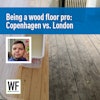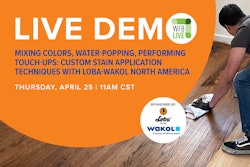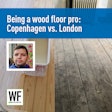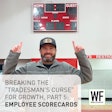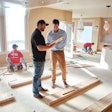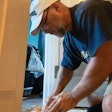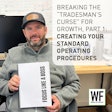I started in the wood flooring business in 1993, and we all know we’ve seen big changes in the wood flooring industry in that relatively short amount of time. Despite those changes, I’ve always thought of the wood flooring business as one with an important contingent of sanding and finishing craftspeople at its core. Some comments I’ve heard recently while out in the industry, however, have made me reflect more on where our industry is going, and what place wood flooring contractor craftsmen—like myself—have in our industry’s future.
Walnut and American cherry were considered exotics back in those days.
When I got started in the wood flooring industry, most of the flooring I was installing was both red or white oaks and maple. Walnut and American cherry were considered exotics back in those days. Most of the flooring I was installing was unfinished; I installed very little prefinished. The company I worked for at the time separated the installation crews from the sand and finish crews. We were usually kept relatively busy; however, not always at the same times. Sometimes the installation crews would have the bulk of the work and other times the sand and finishing crews would be busier (especially in the summer when all the gymnasiums were scheduled to be either recoated or resanded).
Eventually prefinished solid flooring started entering our market, and the installation crews started installing both unfinished and prefinished products. There was a greater demand for hardwood flooring installers at that time, and the number of installers at the company became greater than the number of sand and finishers. Occasionally the installation crews would tease the sand and finish crews about how busy they were when the sand and finish crews complained about how little work they had. The reason for the difference was attributed to the amount of prefinished flooring that the installers were installing. The usual response from the sand and finishing crews when they were teased about not having as much work was, “One day, all of those prefinished floors will have to be resanded, and then we’ll see who’s busy.”
I worked for that company for over a decade and eventually I decided to start my own hardwood flooring contracting business. I had already taken part in numerous National Wood Flooring Association schools and had achieved Installation and Sand & Finish certifications. It was imperative to me to make sure that I was well-rounded before I started my business so that I would not miss out on the sand-and-finish opportunities from new installations, renovations and resanding or refinishing the prefinished floors that were growing in popularity.
Since starting my contracting business, installations have kept me busier, and prefinished installations far outnumber unfinished installations. A lot of my work is installing prefinished engineered flooring. The sand-and-finish work is mainly renovating existing hardwood flooring in residential homes.
The salesperson stated, “Nobody sands and finishes floors anymore.”
A few years ago, I found myself in a small retail hardwood store picking up some material a friend wanted me to install for him. As I was there, I overheard a salesperson speaking with a potential client. The couple were interested in purchasing a prefinished engineered floor, and the salesperson showed the couple several examples. When one of the clients asked the salesperson about the thickness of the wear layer and how many times the flooring could be refinished, the salesperson stated, “Nobody sands and finishes floors anymore.” I was bothered by the salesperson’s comments, and I wondered: Was the salesperson being creative in order to make a sale? Or did he honestly believe that people were not having their floors refinished anymore? I didn’t involve myself in their conversation since it really wasn’t any of my business, nor did I have the time to get into an argument.
Shortly after that encounter, I found myself helping a colleague teach a Hardwood 101 class that was sponsored by a distributor specializing in prefinished hardwood flooring. During that class I heard the same comment again. This time, the comment was made by the general manager of the distribution company. I couldn’t hold my tongue any more, and I had to ask him what he meant by, “No one sands and finishes floors anymore.” He explained it was “impossible to find anyone that could sand and finish floors well.” I disagreed with him and explained that I knew quite a few people locally who were excellent sand and finishers. He didn’t seem too interested in my explanation since the company he represented didn’t sell site-finished products.
Hearing the exact same comment from two people may have been completely coincidental, but it did make me think that there were probably more people in the industry who shared the same opinion.
It doesn’t seem that long ago that I used to see TV repairman vans driving around the old neighborhood. Now, no one fixes a TV—they simply buy a new one. It seems that just about everything manufactured these days is destined for the dump. Manufacturing hardwood flooring that cannot be resanded is a prime example. If consumers are of the mindset that it is better to throw out the old floor and replace it rather than refinish it, there will be less work for sanders and finishers in the future, and they could become extinct, just like the TV repairman.
I started thinking about what we can do to alter the perception that there are no skilled sand and finishers. Certification seems to be the best way to inform people that you are qualified; it tells people that you are actively trying to improve your skills and increase your knowledge. The NWFA Certified Professional’s certification program is comprised of both a written examination and hands-on skill testing. They have recently revamped the way certification testing is carried out. The written test has been updated, and the hands-on testing is thoroughly scrutinized by qualified proctors. It has been the mantra of both the installation and sand and finish certification committees that certification must be earned in order to make it meaningful. Earning your certification means that you can walk the walk and talk the talk.
Networking with people from all over the United States and Canada has shown me that there are a lot of excellent tradespeople in our industry. There is also much progress in the technology of sanding and finishing, helping us achieve a higher standard of quality. Exposing ourselves to the latest technologies and attending schools and workshops will ensure that our trade does not become a lost art and that we don’t become extinct, just like those TV repairmen we used to see not that long ago.













